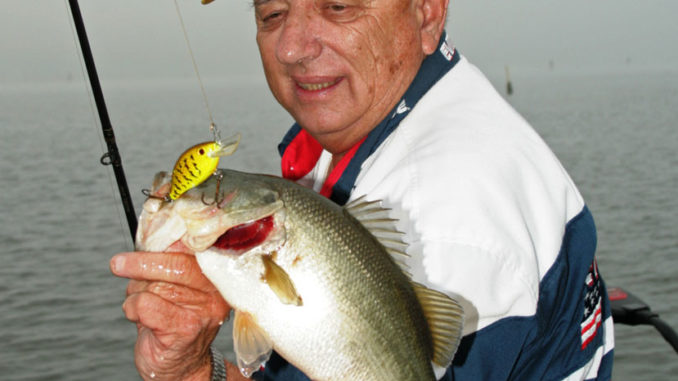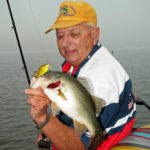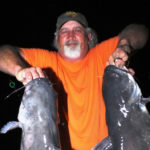
Santee largemouth action warms with weather
Patterns for summer fishing on Lake Marion and Lake Moultrie will vary according to the part of which lake you fish and the species you target. In the main body of both, deep-water areas with plenty of woody cover will produce consistent action for crappie, and to some extent, big bream. A lot of catfish will be in the deeper depths, but they’ll primary be following food more than looking for cover.
In the upper end of Lake Marion and the ring of shallow water and vegetative growth surrounding Lake Moultrie, the dense, shallow-water cover will be prime territory for largemouth bass, as well as ample numbers of bull bream and scattered shellcrackers. Both bass and bream will be a bit deeper than found during their spring spawning fling, but on a broad scale, they’ll be in relatively shallow water, usually less than 8 feet deep and often somewhat less when plenty of cover is available.
Local bass anglers like July, if for no other reason than fishing pressure slacks off considerably. After the mad rush of traffic around the July 4 holiday, pressure on most all species slows.
Guide Inky Davis said the fishing can be excellent through the summer, the key being able to withstand the heat and cover plenty of territory.
“Bass will most definitely be cover-oriented, and often they’ll hold on heavy vegetative cover where most of the sunlight is blocked,” he said.” I look for areas a couple feet deeper than where I caught fish during the spring. If the cover is (close) to slightly deeper water, it’s ideal. I target areas where plenty of cover such as eel grass (and) cypress trees exist. Bass will be able to find plenty to eat in these places and refuge.
Davis (803-478-7289) said casting ability makes an enormous difference, because the prime target zone will usually be quite small, especially for quality fish.
“I feel that you almost have to bump them on the head with an accurate cast,” he said. “When I do, I often get a fairly aggressive bite. But if I’m off by even a few inches, the odds of a bite drop dramatically. I look for tiny pockets along a weedy shoreline, openings in weedbeds, and small weed points. Another excellent place is where two types of vegetative growth converge. This usually draws in more food sources and thus, big bass.”
Davis said depths can vary but typically range from 4 to 8 feet deep in July. A variety of lures will still work, but early and late, topwaters are excellent, with frog-type plastics in heavy cover a favorite.
Another productive pattern in the Diversion Canal when good water flow exists. Davis said to work the blowdowns and other cover along the edge of the Canal with topwater lures early as well as spinnerbaits. During mid-day, the deeper water can be effectively fished with Texas rigged worms.
The heat and humidity are bearing down, but overall, the weather is stable, and that’s good news for catfishing. In the open water of Marion and Moultrie, most of the catfish will be deep. Drift-fishing is the go-to trick for Lake Moultrie, and where cover allows, for the lower end of Lake Marion. On Marion, a lot of the guides work the lower end with all the submerged stumps and cover, using graphs to find big pods of shad. They will then anchor or tie off to trees or stumps sticking out of the water and fan-cast several rigs around the boat.
For either anchoring or drift-fishing, the best baits include whole or cut white perch, gizzard or threadfin shad. Whole live bait, such as a 7- or 8-inch white perch, adds the potential to hook a big flathead. Flatheads are found in both lakes, but Lake Marion — with all the woody cover — seems to harbor more.
Of course, with good current flow through the Division Canal plenty of blue, flathead and channel catfish will be found all along this waterway. A lot of the daytime fishing will be drifting with the current, bumping bottom using a three-way rig. At night, most anglers select a good setup for anchoring and let the catfish come to them. A good bet is to find something a little different where you anchor, such as a slightly deeper hole, a little hump that can change the current flow or the mouth of a cut into the Canal from an adjacent flat. These are the types of spots that may congregate forage, and thus big catfish.
In the upper end of Lake Marion, Andy Pack of Packs Landing said catfish and bream action is still very good.
“We’ll be fishing the deep sides of the river and will use cut perch or shad as cut bait,” Pack said. “This will produce some quality catfish. During the spring striper run, we often anchor on the shallow, inside bends of the river and catch catfish along with the stripers. But during the summer, we’ll target the deeper side of the river for catfish.”
The catfish action is also excellent upstream of the junction of the Congaree and Wateree rivers by fishing deep holes and the bends in the river.
Pack (803-452-5514) also said that good bream action occurs in the swamp during July, but not as good as earlier in the year.
“Limits can still be caught by fishing around trees and weeds for isolated, scattered bream using crickets,” he said. “If anglers use red worms, some shellcrackers can be caught as well.”




Be the first to comment